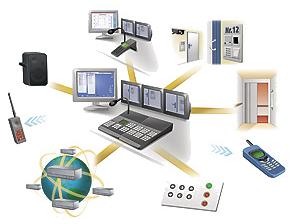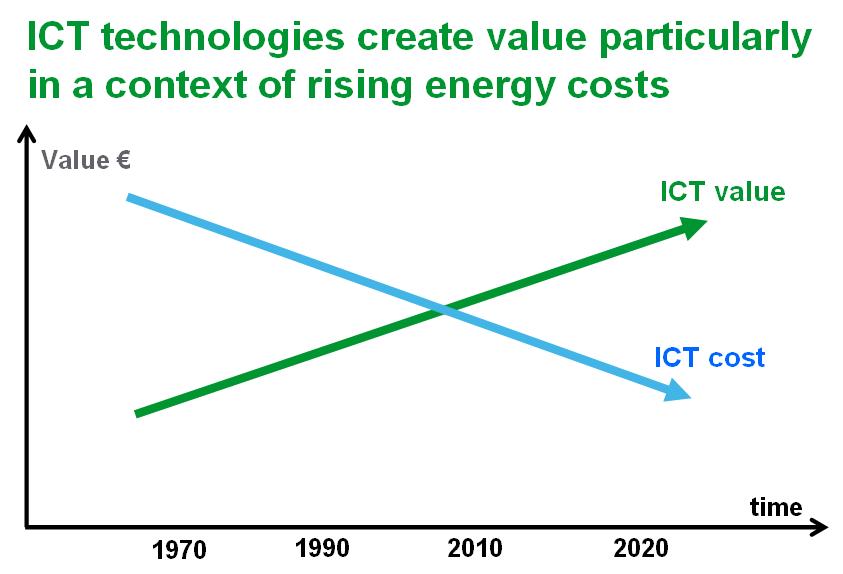Information Technology and Communication = a lever for value creation in energy efficiency
Relevant information can be turned into action to improve energy performance and cost reductions associated.
- Up to 30% reduction in consumption (and therefore costs and associated CO2 emission are accessible)
- The building is one of the key targets: 40% of energy consumption
- 2 degrees gap on the temperature (hot or cold) is 15% of consumption more or less
- The indoor or outdoor lighting : 30% to 50% reduction can be obtained for same service level (lighting is an important item in the energy bill
For each building usage, common as well as specific, optimize its energy consumption (energy just necessary and only when necessary) requires precise knowledge of uses and needs – users’ habits, ICT can capture it.
A gymnasium, a swimming pool, a school, offices have neither the same purposes, nor the same users:
- On weekend, offices and schools willbe empty, notgyms and swimming pools
- Beyond a certain time except urgent situations, public buildings are unoccupied
- The management of temperature in changing rooms and showers are not the same as the gym
- At the end of the match in the enthusiasm of the victory, turnoff the lighting is not the main concern
Only detection of information related to the user and use as well as adequate treatment will allow deciding relevant actions on optimization of energy consumption
Information Technologies and Communication (ICT) is a range of flexible solutions from the very simple to more elaborate for new buildings as well as existing ones
- Programmable switches, presence detectors, daylight switches, programmable outlets, dimmers are examples of stand alone solutions easy to install and use that can bring immediate gains without big investments.
- More elaborate systems of simple centralized technical management systems up to automated building management system (BACS for Building Automation and Control Systems) allow more sophisticated solutions from small buildings (a few hundred m2) to larger (some thousand m2).
- For larger buildings (a few tens of thousands of m2) or for a group of buildings, integration of functions of energy efficiency, security of persons and property management, operation and maintenance permit gains at all steps : the investment, the installation, the operation.
This is the field of Building Management System or BMS.
Flexibility of ICT allows the response to any type of building.
It allows the installation of energy efficiency solutions in new buildings but also in existing buildings without heavy and expensive renovation (do not forget that 80% of the buildings that will exist in 2020 are already built today and that is to say that a massive action on existing buildings is mandatory in order to reach the 20% target for energy efficiency in 2020)
ICT’s are now implementing solutions but they are also the subject of R & D and innovation for even more future features
Miniaturized sensors, autonomous, wireless will help capture more information around the user
Processing capabilities with improved communication features will enable intelligent action in real time
Research & development programmes such HOMES (led by Schneider Electric and combining research lab, universities, medium size companies and large groups) invent new solutions through ICT:
- Taking into account real-time user activity in scenarios tailored to the lifestyle of occupants
- Steering optimized consumption at 3 levels : local, area and building level instead of a steering by usage (the optimum sum amount is not the simple sum of optimums)
In conclusion, ICT is a key lever for the deployment of Active Energy Efficiency
Active Energy Efficiency is (beyond having the equipment or building structure that requires the least energy possible) to consume only the energy required and only when necessary
It requires the deployment of
- the precise measurement of consumption per usage (we can change only what we know, we know only what we measure)
- The control and automation that provide the only necessary power and only when necessary
- The permanent monitoring which allows to act quickly on any drift and to ensure continuous improvement
Mature ICTs today can guarantee up to 30% energy savings for the same level of service; innovation and R & D projects underway will increase this contribution to reducing energy bills, buildings CO2 emission and will fight against climate change
Jean-Jacques MARCHAIS


Interesting, … in line with If you don’t measure, you don’t have control over energy efficiency
regards
Nowadays, the world faces serious environmental challenges and problems that no individuals, companies nor governments can ignore. Our energy consumption has harmful consequences on the environment. In this perspective, more efficient energy consumption is one of the key challenges of today… see article about “Information and Communication Technologies benefits on energy consumption”
http://energy.sia-conseil.com/?p=169
Hi, is there some online seminars or webinars about Property Management on the internet?.*;
some insurance companies are very specific when quoting property damage, some won’t even pay a dime.-‘-
property management is sometimes a tedious task“,
Duties of property management include accepting rent, responding to and addressing maintenance issues, and providing a buffer for those landlords desiring to distance themselves from their tenant constituency ;,`
This are wonderful repeatedly exercise routines when enables us to take it easy a back along with sleep suitably without the working experience relating to demand inside of your once more.